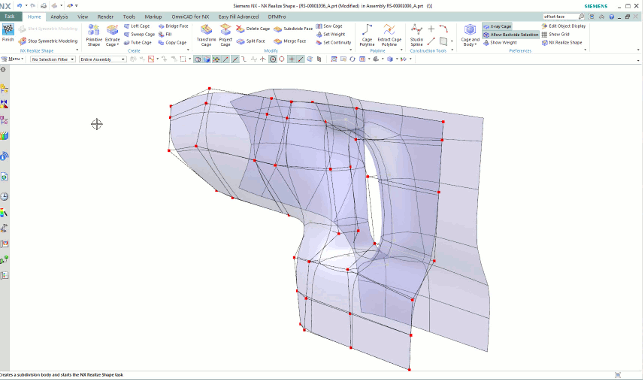
Overview
OS: 64-bit editions of OS X® 10.8.5, 10.9.5, 10.10.2 (OS X® 10.9.5 or 10.10.2 required for ViewNX-Movie Editor) CPU: Photos: Intel® Core or Xeon® series series Movies: (playback) 2 GHz Core™ Duo or better; Intel® Core™ i5 or better recommended for HD and Full HD playback Movies (editing) Intel® Core™ i5 or better. NX 10 Training Exercises. NX 10 introduces NX Layout, an easy-to-use 2D conceptual design environment that is fully integrated into the NX Drafting application. You can explore concepts in 2D and then use that data to generate 3D models and assemblies. With NX 9 we introduced the Microsoft Ribbon approach for user interaction. NX Student Edition NX Student Edition software, you can model products with 3D CAD and learn machine tool programming to gain insight into how products are manufactured – all using a single integrated software solution. The latest version of NX course is available. Please search 'Siemens NX 1847 - Essential Training'!!! In this Siemens NX 10 Essential training course, Expert author Asif Ahmed, (Siemens NX Expert) will teach you how to create sketch, parts, assembly and drawing file using the variety of tools in Siemens NX. Samsung NX 10mm Fish Eye Camera Lens (White) 4.8 out of 5 stars. Only 1 left in stock - order soon.

yargs-parser is a mighty option parser used by yargs.
Affected versions of this package are vulnerable to Prototype Pollution. The library could be tricked into adding or modifying properties of Object.prototype using a __proto__ payload.
Our research team checked several attack vectors to verify this vulnerability:
- It could be used for privilege escalation.
- The library could be used to parse user input received from different sources:
- terminal emulators
- system calls from other code bases
- CLI RPC servers

PoC by Snyk
Details
Prototype Pollution is a vulnerability affecting JavaScript. Prototype Pollution refers to the ability to inject properties into existing JavaScript language construct prototypes, such as objects. JavaScript allows all Object attributes to be altered, including their magical attributes such as _proto_, constructor and prototype. An attacker manipulates these attributes to overwrite, or pollute, a JavaScript application object prototype of the base object by injecting other values. Properties on the Object.prototype are then inherited by all the JavaScript objects through the prototype chain. When that happens, this leads to either denial of service by triggering JavaScript exceptions, or it tampers with the application source code to force the code path that the attacker injects, thereby leading to remote code execution.
There are two main ways in which the pollution of prototypes occurs:
- Unsafe
Objectrecursive merge - Property definition by path
Unsafe Object recursive merge
The logic of a vulnerable recursive merge function follows the following high-level model:

When the source object contains a property named _proto_ defined with Object.defineProperty() , the condition that checks if the property exists and is an object on both the target and the source passes and the merge recurses with the target, being the prototype of Object and the source of Object as defined by the attacker. Properties are then copied on the Object prototype.
Clone operations are a special sub-class of unsafe recursive merges, which occur when a recursive merge is conducted on an empty object: merge({},source).
lodash and Hoek are examples of libraries susceptible to recursive merge attacks.
Nx 10 Pdf
Property definition by path
There are a few JavaScript libraries that use an API to define property values on an object based on a given path. The function that is generally affected contains this signature: theFunction(object, path, value)
If the attacker can control the value of “path”, they can set this value to _proto_.myValue. myValue is then assigned to the prototype of the class of the object.
Types of attacks
There are a few methods by which Prototype Pollution can be manipulated:
| Type | Origin | Short description |
|---|---|---|
| Denial of service (DoS) | Client | This is the most likely attack. DoS occurs when Object holds generic functions that are implicitly called for various operations (for example, toString and valueOf). The attacker pollutes Object.prototype.someattr and alters its state to an unexpected value such as Int or Object. In this case, the code fails and is likely to cause a denial of service. For example: if an attacker pollutes Object.prototype.toString by defining it as an integer, if the codebase at any point was reliant on someobject.toString() it would fail. |
| Remote Code Execution | Client | Remote code execution is generally only possible in cases where the codebase evaluates a specific attribute of an object, and then executes that evaluation. For example: eval(someobject.someattr). In this case, if the attacker pollutes Object.prototype.someattr they are likely to be able to leverage this in order to execute code. |
| Property Injection | Client | The attacker pollutes properties that the codebase relies on for their informative value, including security properties such as cookies or tokens. For example: if a codebase checks privileges for someuser.isAdmin, then when the attacker pollutes Object.prototype.isAdmin and sets it to equal true, they can then achieve admin privileges. |
Affected environments
The following environments are susceptible to a Prototype Pollution attack:
- Application server
- Web server
How to prevent
- Freeze the prototype— use
Object.freeze (Object.prototype). - Require schema validation of JSON input.
- Avoid using unsafe recursive merge functions.
- Consider using objects without prototypes (for example,
Object.create(null)), breaking the prototype chain and preventing pollution. - As a best practice use
Mapinstead ofObject.
For more information on this vulnerability type:
Remediation
Spectrum Nx 10
Upgrade yargs-parser to version 5.0.1, 13.1.2, 15.0.1, 18.1.1 or higher.